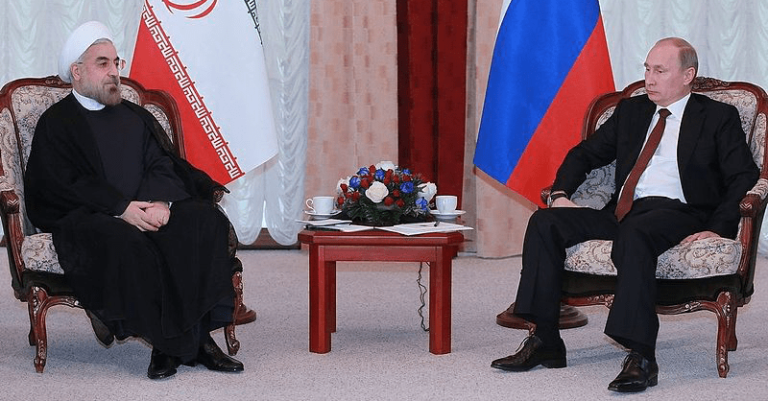
As Syria’s civil war draws to a close, Iran’s activity in the country is coming under increasing scrutiny. The US, Israel, and the Gulf states are all working towards making Iran’s military presence in Syria untenable and its withdrawal – a prerequisite for resolving the conflict.
The Trump administration is not as tolerant of Iran’s regional ambitions as its predecessor. The Pentagon has maintained US military presence in Syria after the defeat of the Islamic State of Iraq (ISIL) and the Levant in order to stop Iran from establishing a land corridor from Iraq to Lebanon, through Syrian territories.
Over the past year, the US-led coalition has succeeded in preventing Iranian-backed militias from establishing a foothold on the eastern bank of the Euphrates River, near the border with Iraq.
The US has also blocked these militias from advancing towards al-Tanf border crossing between Syria and Iraq near the Jordanian border, where it maintains a military presence to monitor Iranian movement on the main road between Baghdad and Damascus.
Over the past year, there has been a shift in Israel’s Syria policy, too. From the beginning of the Syrian civil war in 2011 to mid-2017, Israel had a hands-off policy, which worked in Iran’s favour.
During this period, Israel tolerated Iranian military presence in Syria, as its main objective was to help sustain the Syrian regime and prevent an opposition victory. Israel did not perceive the Syrian conflict as a threat, as it weakened its foes on both sides of the divide.
Last year, however, Israel’s policy shifted in response to a new Iranian strategy in Syria. Since the beginning of the conflict, Iran’s primary objective was to defend Assad.
Yet last year, as it became clear that Assad was winning the war, it started to work towards establishing a permanent military presence in Syria to challenge Israel. Iran’s end game was to set up paramilitary forces independent from the Syrian government and loyal to Tehran – similar to Hezbollah in Lebanon. That posed a direct threat to Israeli interests.
In July 2017, Israel tried to insert a clause in a de-escalation agreement between the US, Jordan and Russia to keep Iranian forces at least 40km away from the occupied Golan Heights, but failed. As a result, it decided to take the issue into its own hands. Since early 2018, the Israeli air force has intensified strikes against Iranian bases and outposts across Syria.
Russia is undoubtedly alarmed by the escalation of tensions, but it also views it as an opportunity. A confrontation between the two regional foes in Syria could undermine its strategy aimed at ensuring the survival of the Assad regime, rebuilding the Syrian army and resurrecting the state bureaucracy and the security apparatuses. But Moscow could also use the Israeli pressure as leverage against Tehran to force it to fall in line with its Syria policy.
The Syrian government’s onslaught on Deraa backed by Russian forces showed that the Russians and the Israelis have already identified some common interests in southwest Syria.
According to the Washington Post, an agreement has been reached to keep Iran away from the Golan Heights in exchange for allowing the Syrian regime to regain control over the opposition-held territories in the southwest.
The Russians seem willing to go even further. They want to strike a broader deal with the Trump administration to trade US military presence in Syria with that of Iran. That would include the US pulling its troops out of the Kurdish-held Syrian territories east of the Euphrates and from the al-Tanf base in the southeast of the country.
This option seems to have been discussed during the June 27 visit of US National Security Adviser John Bolton to Moscow and it is likely to be finalised at the upcoming Helsinki summit between US President Donald Trump and Russian President Vladimir Putin.
If such a deal is made, it would make almost everyone happy, except Iran. It would please the Israelis, the Gulf states, the Assad regime, the Americans and, indeed, the Russians, who have emerged as the biggest winners in the Syrian civil conflict.
It was Iran that invited Russia in 2015 to help ensure the survival of the Syrian regime after it failed to stop the advances of the opposition. The Russians answered the call and rescued the Assad regime, but they seem to be planning to throw the Iranians under the bus at the earliest opportunity.
In recent months, the Iranians have become increasingly wary of Russia’s policies in Syria and elsewhere. They complain that the Russians are doing nothing to stop the movement of the Israeli air force over Syria despite having anti-aircraft missile systems stationed in the country, including the S-400. This has led some to believe that Russia condones Israel’s actions against Iran in Syria.
The Russians also took an ambivalent position when Trump decided to withdraw the US from the Iran nuclear deal.
Russia’s acting deputy foreign minister, Sergei Ryabkov, even suggested that Iran should make some concessions to save the deal. To add insult to injury, Russia sided with Saudi Arabia – Iran’s arch enemy – when the increase of oil production to restrain prices was discussed.
Before OPEC’s latest meeting, Russia pressured Iran to drop its reservations on the issue. It is very likely that Russia and Saudi Arabia are planning to compensate for any shortages in the oil market that may arise as a result of the US sanctions against Iran which will take effect in August.
Over the past seven years, Iran has invested heavily in Syria. It threw its weight behind the Assad regime, providing both financial and military support. Hundreds of Iranian Revolutionary Guards – Quds Force (IRGC-QF) and intelligence personnel have been killed in Syria.
According to the UN special envoy, Staffan de Mistura, Iran spends $6bn annually to prop up Assad. To make a return on its investment, Iran was hoping to take on a sizable part of Syria’s post-war reconstruction. All these investments are now at risk of being lost.
Indeed, Iran will do everything in its power to resist any attempt to be forced out of Syria, a very important asset in its geopolitical game. If it were to lose it, its grip on Iraq would also be weakened and its only direct land route to Lebanon, where its key ally Hezbollah is based, would be blocked.
This could cause Iran’s entire Middle East project to collapse. According to one Iranian official, Syria is more important to Iran than its oil-rich southern province of Khuzestan.
Yet, Iran’s options appear to be limited. It would find it very difficult to resist the emerging US-Russian-Arab-Israeli consensus on throwing its forces out of Syria to stabilise the war-torn country.
All in all, the Syrian civil war – a conflict that was once seen as Iran’s greatest regional victory – may end up becoming its greatest regional failure in the near future.
This article was originally published by Aljazeera on July 4, 2018. The original can be viewed here

